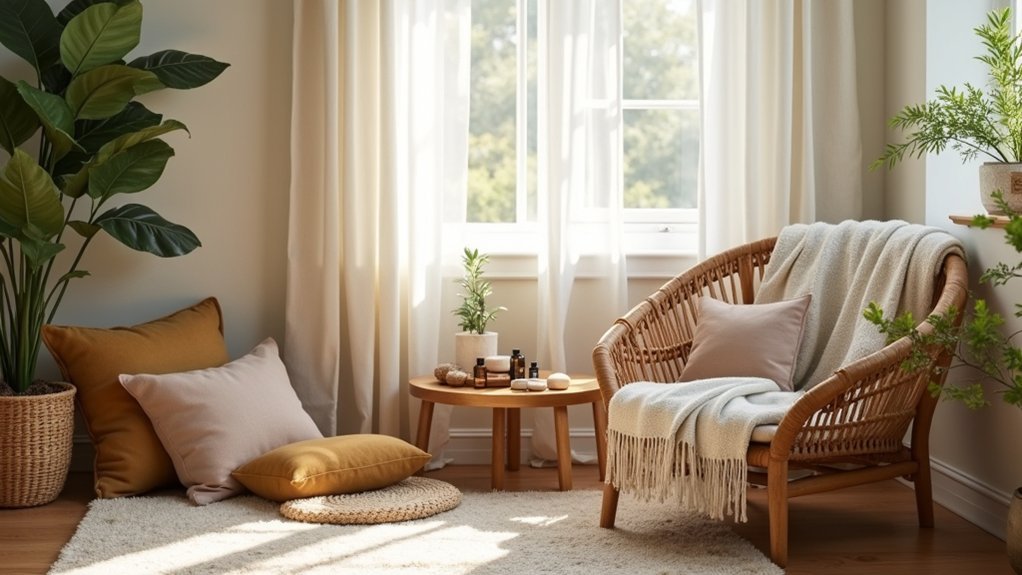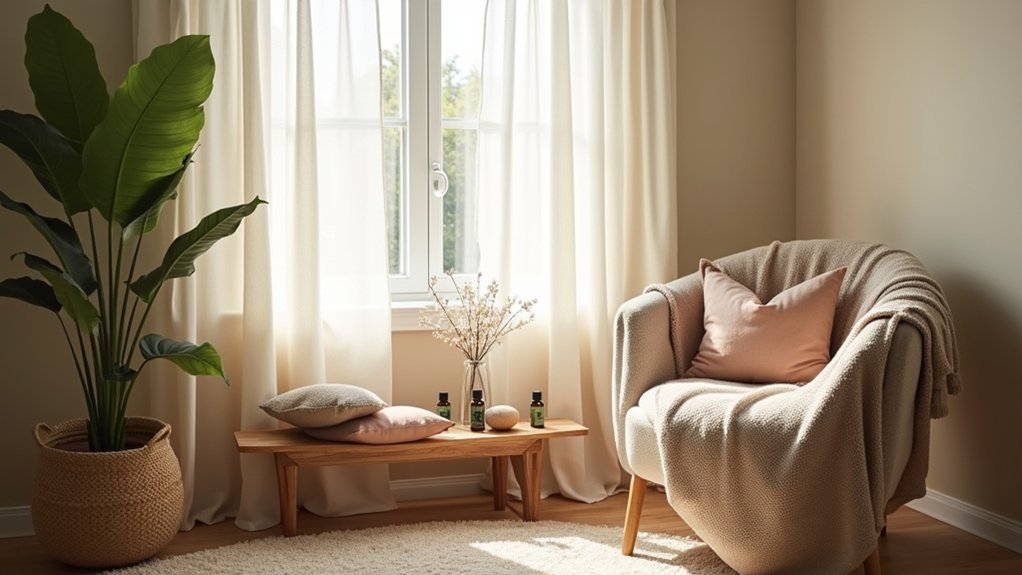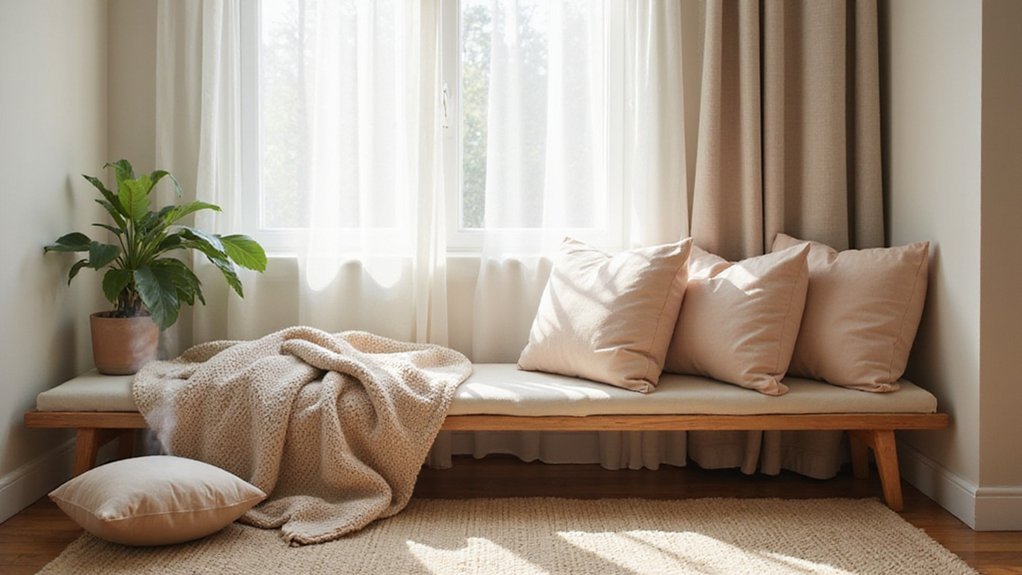Imagine a sanctuary where your senses breathe a sigh of relief, where every texture and hue speaks directly to your comfort. Creating a sensory-friendly self-care space isn’t just about design—it’s about understanding how your environment can support your emotional and neurological well-being. If you’ve ever felt overwhelmed by traditional spaces, you’re not alone. This guide will show you how to transform an ordinary room into a personalized haven that adapts to your unique sensory needs, offering a blueprint for calm and restoration.
Key Takeaways
- Select soft, muted colors like blues and neutrals to create a calming visual environment that promotes relaxation and minimizes sensory overstimulation.
- Incorporate adjustable lighting with dimmable options and natural light to control brightness and create a soothing sensory atmosphere.
- Use tactile elements like weighted blankets, plush cushions, and soft textures that provide comforting deep pressure and sensory input.
- Integrate noise-reducing tools such as noise-canceling headphones and create an organized space with minimal visual clutter to manage sensory distractions.
- Personalize the space with meaningful artwork, photographs, and sensory tools that reflect individual preferences and support emotional well-being.
Understanding Sensory Processing and Self-Care

Sensory sensitivity can transform self-care from a routine into a deeply personalized experience. Understanding sensory processing helps you recognize how your nervous system interprets sensory information and impacts your emotional regulation. By identifying your personal sensory preferences, you can create a sensory-friendly environment that supports your well-being.
Your unique sensory sensitivities might mean certain textures, lighting, or sounds greatly affect your relaxation. Developing a supportive environment with calming colors and soothing sounds can enhance your self-care routine. Pay attention to what triggers comfort or discomfort, and design spaces that accommodate your specific needs.
Embracing your sensory profile allows you to craft intentional self-care strategies that genuinely nurture your physical and emotional health, making each moment of care more meaningful and effective.
Essential Elements of a Sensory-Friendly Space

Building on your understanding of sensory processing, creating a self-care space requires thoughtful design that caters to your unique sensory needs. Start by incorporating soft furnishings like bean bags and plush cushions that provide comfort and support. Choose an adjustable lighting system with dimmable lamps or soft LED lights to control sensory input. Select calming colors such as soft blues and neutrals to promote tranquility and reduce anxiety. Integrate essential sensory tools like noise-canceling headphones, fidget toys, and weighted items to assist with emotional regulation. Maintain an organized environment with minimal visual clutter, featuring gentle textures and natural elements that create a serene retreat. These strategic design choices will transform your space into a personalized sanctuary that respects and supports your sensory processing preferences.
Lighting and Color Strategies for Sensory Comfort

When designing a self-care space, lighting and color play critical roles in creating sensory comfort. You’ll want to prioritize soft lighting that can be easily adjusted, such as dimmable LEDs or warm-colored bulbs, to establish a soothing atmosphere. Utilize natural light by incorporating adjustable shades or curtains that allow you to control brightness and reduce overstimulation.
Choose a color palette featuring muted tones like soft blues, greens, and pale pinks to promote relaxation in your sensory-friendly space. Avoid bright or neon colors, especially reds, which can trigger anxiety. Complement your color choices with gentle textures like fleece blankets and soft cushions to enhance the calming environment. By thoughtfully selecting lighting and colors, you’ll create a space that supports your sensory needs and promotes well-being.
Selecting Calming Sensory Tools and Textures

Since creating a sensory-friendly self-care space requires thoughtful selection of tools and textures, you’ll want to prioritize items that provide calming stimulation and promote emotional regulation. Choose tactile sensory tools like stress balls, fidget spinners, and squishy toys that can help reduce anxiety and enhance focus. Incorporate soft textures such as fleece blankets and plush pillows to establish a cozy atmosphere that encourages relaxation.
Weighted blankets and vests offer deep pressure input, helping you feel grounded and secure. Complement these tools with soothing colors like soft blues and muted earth tones to further calm your sensory environment. Noise-canceling headphones can minimize auditory distractions, creating a peaceful space that supports your emotional well-being and provides a sanctuary for self-care.
Personalizing Your Sensory Self-Care Environment

Because personalization transforms a generic space into a meaningful sanctuary, creating a sensory self-care environment that reflects your unique preferences becomes vital. Your space should embody your individuality through carefully selected elements that promote relaxation and emotional well-being.
- Choose calming colors like soft blues and muted earth tones that resonate with your personal aesthetic, enhancing the space’s soothing atmosphere
- Incorporate tactile elements such as soft blankets, weighted items, and textured cushions that provide comfort and offer soothing sensory input
- Add personal touches like favorite artwork, meaningful photographs, or cherished objects that strengthen emotional connections and create a sense of ownership
An accessible, organized environment guarantees your self-care space remains a consistent retreat for rejuvenation and emotional stability.
Frequently Asked Questions
How Do You Set up a Sensory Space?
You’ll want to strategically place sensory tools, choose calming colors, incorporate textured materials, and arrange furniture to create a soothing environment with sound reduction, light control, and privacy options for ideal comfort.
How Do You Create a Sensory-Friendly Environment?
Create a sensory oasis where calm waves wash over you. Select soothing colors, soft lighting, and noise-reducing elements. Incorporate tactile materials, comfortable seating, and personal touches that transform your space into a tranquil sanctuary of comfort and peace.
How to Make a DIY Sensory Room?
You’ll create a DIY sensory room by selecting a quiet space and adding sensory wall elements, calming colors, soft lighting, tactile materials, floor cushions, sound machines, and interactive toys that support relaxation and comfort.
How Do You Build Sensory Space for Adults?
You’ll create a sensory space by integrating calming color palettes, textured materials, ambient lighting, and nature-inspired elements. Incorporate comfort items, use soundproofing strategies, and apply minimalist design principles to support personal mindfulness and sensory regulation.
Conclusion
Your sensory sanctuary isn’t just a space—it’s a fortress of solitude where stress melts like Dali’s clocks. By intentionally crafting an environment that nurtures your nervous system, you’re transforming a room into a healing landscape. Remember, this isn’t about perfection, but creating a personalized retreat that whispers calm and supports your unique sensory needs. Embrace your space, and let self-care become your most powerful form of resilience.



